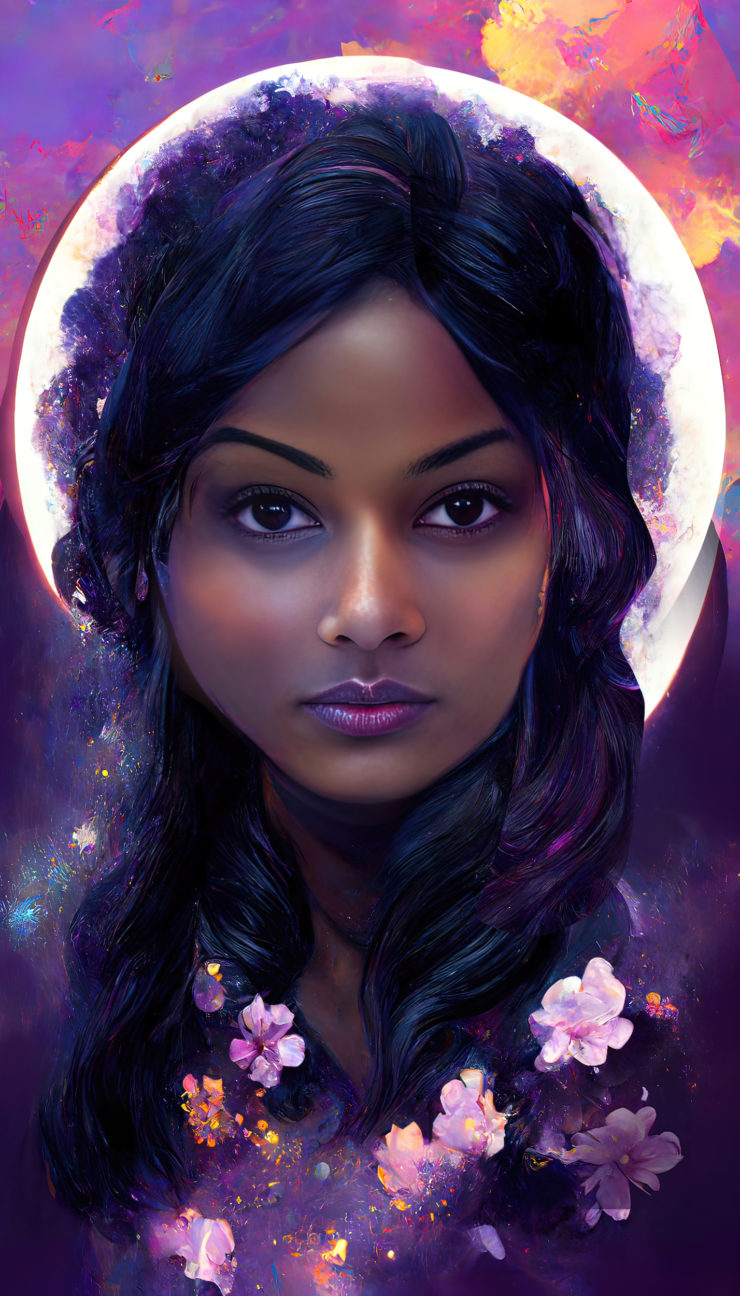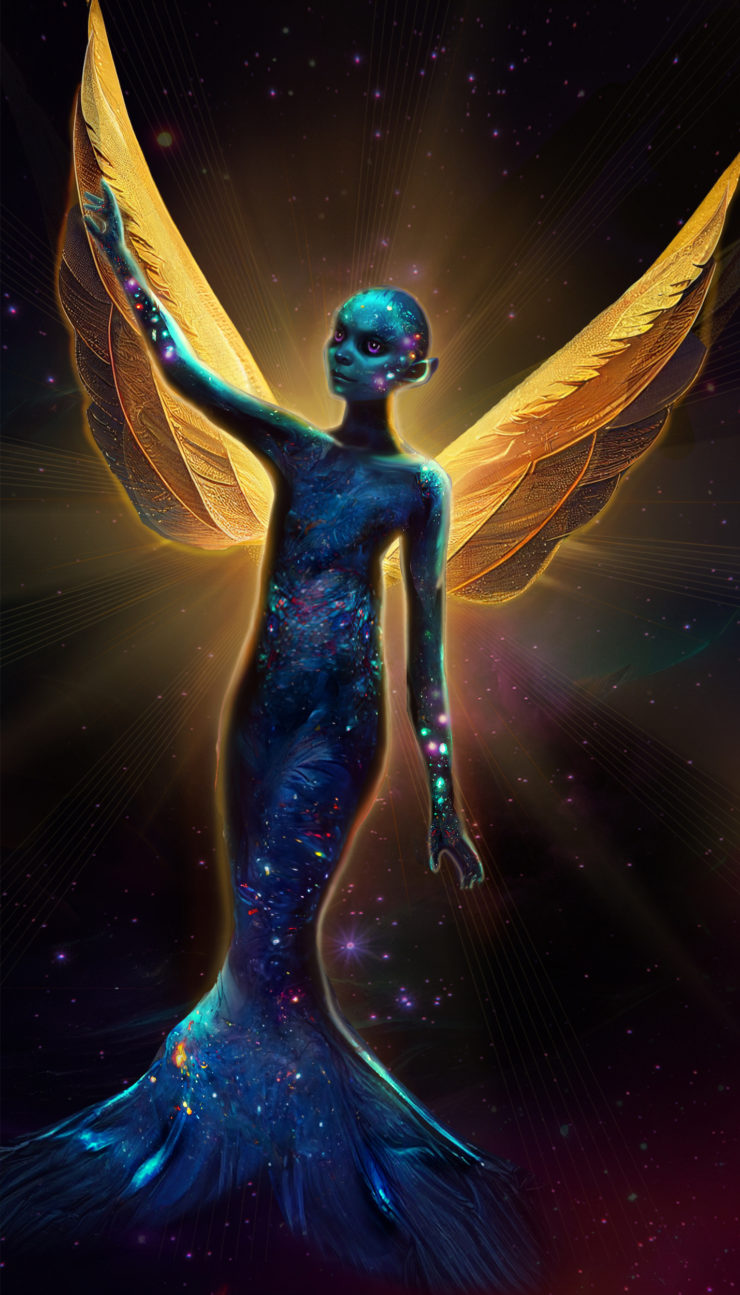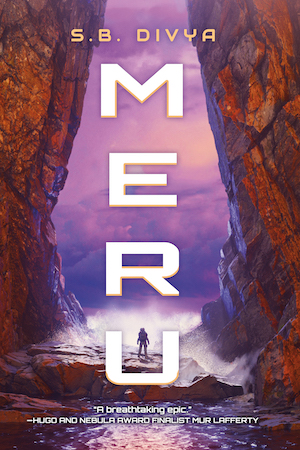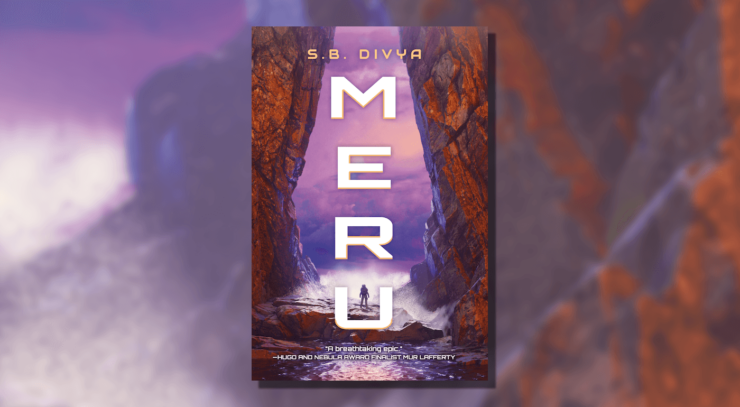One woman and her pilot are about to change the future of the species…
We’re thrilled to share an excerpt and reveal character art for S. B. Divya’s Meru, an epic space opera about aspiration, compassion, and redemption—available now from 47North.
For five centuries, human life has been restricted to Earth, while posthuman descendants called alloys freely explore the galaxy. But when the Earthlike planet of Meru is discovered, two unlikely companions venture forth to test the habitability of this unoccupied new world and the future of human-alloy relations.
For Jayanthi, the adopted human child of alloy parents, it’s an opportunity to rectify the ancient reputation of her species as avaricious and destructive, and to give humanity a new place in the universe. For Vaha, Jayanthi’s alloy pilot, it’s a daunting yet irresistible adventure to find success as an individual.
As the journey challenges their resolve in unexpected ways, the two form a bond that only deepens with their time alone on Meru. But how can Jayanthi succeed at freeing humanity from its past when she and Vaha have been set up to fail?
Against all odds, hope is human, too.
S.B. Divya is a Hugo- and Nebula-nominated author whose work includes Machinehood, Runtime, and the short-story collection Contingency Plans for the Apocalypse and Other Possible Situations. Her stories have been published in various magazines, such as Analog and Uncanny; on Tor.com; and in several anthologies, including Seasons Between Us and Rebuilding Tomorrow. She holds degrees in computational neuroscience and signal processing, and she worked for twenty years as an electrical engineer before becoming an author. A lover of science, math, fiction, and the Oxford comma, she enjoys subverting expectations and breaking stereotypes whenever she can.
I am excited to introduce readers to the world of Meru, a far future space opera inspired by one of my favorite stories from the Mahabharata. I wrote this novel during the spring and summer of 2020, and it provided a welcome escape from the realities of the Covid pandemic. It’s full of adventure and travel, both of which I dearly missed during months of self-quarantine and social shutdown.
The two main characters are Jayanthi and Vaha. Jayanthi is a human woman living on Earth who dreams of breaking free from her home planet and pushing the boundaries of acceptable behavior. Vaha is an alloy, a genetically engineered post-human who lives in space and has a massive body capable of interstellar travel. Together, they travel to the first Earth-like planet that can naturally support human life.
I commissioned portraits of both characters as a treat to myself after selling the book (and a companion novel set in the same universe). The artist is electric bunny, and you can find her on Instagram, which is where I discovered her beautiful work. I trusted her to bring both of them to life, especially Vaha, who was the bigger challenge since there was no model to work from. I’m thrilled with the results, and I hope readers are too!
–S. B. Divya


—गुरु
Guru—Teacher
Jayanthi stood atop the hill, her legs protesting less than usual from the climb. Ahead of her, the land settled into a wide plain followed by a series of hills marching up to graceful mountains. To her right, the town of Vaksana blended into the terrain, with low buildings topped by plant-covered roofs. Where teeming masses of humanity had once dumped their excess garbage, megaconstructs now tore down ancient concrete and steel structures with their metal appendages. They towered over sluglike alloys, themselves as tall as trees, who crawled through the rubble, consuming and digesting it, leaving behind fertile organic waste.
A temperate breeze dried Jayanthi’s sweat. After catching her breath, she continued along a path that wound down to the base of the hill. Red and tan grasses covered the gentle slope. Insects swarmed to patches of sedate flowers, and microconstructs glittered in their midst, filling the ecological niches that had lain empty for centuries. For part of the way, she could pretend like she was the only human around. Feathery seed pods tickled her palms, and she resisted the instinct to break off a stem. Only a child would harm a plant for no reason, and at twenty-two years old, she was well into adulthood. Instead, she slackened her pace, letting her breath slow, and clasped her hands behind her back.
She entered her family home from the rear, passing under the ancient banyan tree and through the privacy curtain. Art produced by human hands lined the hallway: a quantum-interpretive painting by Charan, a figurine carved from regen-redwood, a painted earthen jug. In the front room, late-morning sunlight filtered through vine-covered windows and painted green shadows over everything, including her alloy father, who reclined in a sling chair.
He peeked over the top of a print book and said, “Share your bodym.”
Out of respect for Jayanthi’s privacy, her parents had withdrawn their access to her body’s information network after she reached the age of sixteen. Alloys did that with their children, relinquishing all oversight and control upon their offspring’s maturity. Jayanthi was entirely human and shouldn’t have had a bodym at all. The technological enhancement had been a concession—one of many—to her more-than-human parents.
Buy the Book


Meru
“I’m fine,” she grumbled. “Stop worrying.”
But she sent her vital metrics over to her father anyway. Telling a parent not to worry was like asking the sun to dim its light.
Vidhar nodded. “Your oxygen and hemoglobin counts are good.”
Jayanthi shot him an I told you so look. “Have you heard from Hamsa?”
“He’ll be here soon. Did your walk not cure your nervousness?”
“I’m not nervous,” she said. She sat and put her feet up to prove it.
Hamsa had visited her parents every other year for as long as Jayanthi could remember. He and her parents had completed a fifteen-year course on human studies at the same time, and they’d remained close friends ever since. She’d never heard Hamsa criticize them for taking permanent residence on Earth. Most of the alloys who lived planet-side did so because of forced community service. The ones who did it by choice got branded as human lovers or wellers. Her parents claimed that the epithets didn’t bother them, but for Jayanthi, their oh-so-human child, the labels delivered a sting.
When Jayanthi was young, Hamsa would bring her gifts: intricate filigree balls that flattened into plates after months in Earth’s gravity, stick-on chromatophores that changed color with the temperature of her skin. In later years, he’d nurtured her growing interest in studying genetic engineering. Her own DNA contained HbSS—sickle cell anemia, a disease long since eradicated from Earth—and in learning about it, she’d become fascinated with genetics. Her existence was an anomaly, a conscious choice to revive an old genome, but historically, there had been many people like her, and the more she’d learned at Hamsa’s knee, the more convinced she’d become that other extinct genes deserved renewed exploration. Alloys had an incredible variety of genes that spanned all kinds of life-forms. Humanity, on the other hand, had narrowed their options over time, choosing security and comfort over risk and diversity.
Hamsa had been a tarawan before he’d gotten involved in politics. His skills in producing alloy offspring were widely recognized. Under his tutelage, she’d learned to combine chromosomes, introduce mutations, and strategically edit genes—to access knowledge that was available only to alloys. Since his previous visit, she’d been working on a new genetic design, something innovative that she hoped would impress him . . . maybe enough to let her work as a tarawan and make human history.
“Hello,” called a singsong voice from beyond the entrance curtain.
Jayanthi leaped from her chair and pulled the front entry curtain aside. Hamsa spread his feathered arms and smiled wide and close-mouthed, in the alloy style, though his incarn—the temporary body that he used on Earth—could breathe air. She flung her arms about his waist. He wrapped her in a downy embrace. A sleeveless tunic, white like his feathers, covered his torso. She inhaled his scent and reveled in its earthy, animal quality.
He pulled back and ushered her inside. “How are you, my dear?” The bird genes gave his voice a scratchy quality.
“I’m very well,” she said.
“Does that mean you opted for the gene therapy?”
Jayanthi shook her head. “No. I had a blood exchange recently, and I’ve started a new type of medicine.”
Vidhar came forward and flashed a greeting to his friend. Her parents’ incarns had a more humanlike appearance, except for being hairless, but as with all alloys, they had chromatophores along their arms, cheeks, and neck. Vidhar’s traced delicate spirals across his dark skin, like the ancient symbols for air.
“Where’s Kundhina?” Hamsa asked aloud, after responding with his own phores.
“In Paris, but she’ll return tomorrow,” her father replied. “She’s working on a theory about human interment methodologies, and she’s in the catacombs there.”
“Sounds fascinating,” Hamsa said.
Jayanthi left them to catch each other up and busied herself in the kitchen. Alloys—and their incarns—had ways to get energy other than via food, but Hamsa and her father would eat, and her own stomach rumbled for lunch. Keeping her hands busy kept her thoughts occupied rather than fretting over pleasantries until she and Hamsa could get to work.
Their voices stopped as soon as she exited the room. Her parents had insisted on using speech with each other, both for Jayanthi’s sake and to keep themselves in practice, which meant she could understand only the simplest phoric. When other alloys came to visit, they would switch back to their natural mode of communication. At least they’d given her the use of an emchannel. As with her bodym, most human beings didn’t have the ability, typically conferred by an alloy’s extra chromosome. The molecular devices could be installed after birth, as they were for alloys whose emtalk or bodym didn’t take in the womb, but that didn’t always work on humans. She was grateful that hers had. Not only did it allow her to communicate nonverbally with alloys, it let her interface to devices with her thoughts.
Jayanthi sliced a Black Beauty tomato and placed it on a hot grill next to three slabs of tofu. As they warmed, she ground walnuts and figs in a mortar and pestle, then spread the paste on slices of bread that Vidhar had baked the day before. She topped that with the tomato and tofu and carried it out on a tray. Her best friend, Mina, would have scoffed at the lack of seasoning, but Jayanthi didn’t share their interest in cuisine, and her father wouldn’t care.
Hamsa made a show of inhaling and said, “That smells wonderful.”
She gave him a sideways glance. “You don’t have to pretend. I’m an adult now. I won’t take offense.”
Hamsa honked with laughter. “Compared to my two hundred and eighty-seven years, you are very much a child. I appreciate the offer to drop old pretenses, but I’ll attempt to eat. Where else would I get to taste such a . . . a . . .” He looked at Vidhar for help.
Her father’s phores flashed.
“Sandwich,” Hamsa finished, as if he’d known all along.
Jayanthi laughed. “If you stayed longer, you’d learn more food names.”
“If a womb could grow my incarn faster, I might consider it, but one month on Earth is all I can afford with my other responsibilities.”
After lunch, Vidhar resumed his work. Hamsa and Jayanthi moved outside and sat under the shade of the banyan tree.
“You said you had a surprise for me,” Hamsa said. “Let’s see it!”
Six months earlier, Hamsa had assigned Jayanthi a thesis-level project: one that involved design changes to her own chromosomal DNA.
“Pretend you’re making your child in the alloy way,” he’d said. “You decide what portions of yourself to pass on, what to take from other human beings, and what to mutate randomly, all within the allowed proportions as defined by the Genetic Review Board.”
She’d worked on nothing else in the interval, but she’d added her own twist: rather than using genes from another human being’s chromosomes, she’d taken some from an alloy’s Z chromosome and worked it into her design. It was as if she’d had sex with a humanoid incarn, like those that her parents inhabited. The two were entirely different species and couldn’t reproduce naturally, but making such a person possible was exactly what tarawans did. Alloys didn’t have children in the traditional sexual way. They designed theirs. A tarawan would take the maker’s genes and combine them with any other genetic information from a central data bank. They’d introduce random mutations as well as epigenetic tweaks to produce a new being whose biology would add to the diversity of the population.
She handed Hamsa the data cube with her genomic solution and tried not to fidget as he pulled a simulator from his pocket. With only one meeting per year, her progress was far slower than she would have liked, but only someone licensed by the Tarawan Ethics and Standards Council could operate a simulator.
Hamsa placed the cube in the device and set it on the ground. “I haven’t had a chance to review your latest notes. Tell me about your parameters.”
Jayanthi thought-asked to share her visual overlay data with him, then showed him the choices she’d made. “For the epigenetic edits to my half, I increased the expression of sickle cell, since it has protective effects against certain tropical diseases, and boosted melanin levels for skin protection. I emphasized lean muscle mass and metabolic efficiency to balance the hypoxic effects.” She talked him through another thirty specific edits and her reasons for them.
Hamsa nodded along until she finished, then said, “And mutations?”
“A 0.03 percent chance of mutations, and an additional 0.01 percent on the epigenetic factors.”
“That’s very conservative. If you play it too safe, you reduce the chance of novelty. Tarawans have to embrace risk. What is the primary axiom?”
Jayanthi swallowed a protest. She’d memorized the axioms in her teens. “There’s no such thing as a bad gene,” she recited. “Only one that’s ill-suited to its environment.”
“Good. Now, think hard about what those words mean. If you want to be a tarawan, you have to get comfortable with risks and mortality. Every life-form must have a nonliving state. There’s no shame in giving birth to one that moves quickly into the latter. Greatness finds those—”
“—who work without fear. I know.” She hesitated, then said, “Here’s where I took the risk.”
She revealed the complete set of her new being’s DNA to Hamsa. She’d used a rare human condition called genome-wide uniparental disomy as her basis. It meant that the child’s genes came primarily from one parent. In nature, it usually happened to females, who would inherit the majority of their DNA from their father’s sperm. For Jayanthi’s experimental design, she’d taken that foundation and used an alloy’s Z chromosome for the mother and her own X chromosome for the father. She selected for genes that produced chromatophores, that allowed alloys to subsist on a liquid diet, and—her boldest move—to grow solar wings and replace one air-based lung with a version that held water.
Hamsa’s phores stayed neutral. Jayanthi’s phoric was terrible, but she had learned to interpret the colored glows around the edges that substituted for facial expressions. A lack of color was the equivalent to a blank face.
“Do you expect this to be a viable person?” he asked.
She quoted the fourth axiom. “Information can be gained from nonviable outcomes as often as it can from the viable.”
“And do you think this is a novel idea, to design a being who can survive in both an atmosphere and in the vacuum of space?”
“I . . . hoped so,” she admitted.
“This type of being was tried again and again in the first century of the human era. It was one of the causes of the directed mutation catastrophe.”
“Oh.” She couldn’t hide the disappointment in her voice. “How could I have known that? I don’t have access to the genomic data in the Nivid, and without the knowledge base, I can’t check my designs against prior data.”
A green dot lit on an upper corner of the simulator. Hamsa pulled out the data cube and handed it back to Jayanthi. Her design had an approximately 92 percent chance of viability.
“Far too low for approval from a genetic review board,” Hamsa said.
“It’s not terrible, though. With more time and iterations, I could get it right. I’m capable of doing this successfully. I just need a chance—”
“No.” His voice was gentle. “I’m sorry, Jaya. I can’t ask TESC to allow a human to access that information. Have patience. Play the long game. We can only change so many things at a time, and my priority right now is to find a way for humans to safely leave Earth. I can’t risk the goodwill I’ve built to push for one of you—even if she’s my favorite—to work as a tarawan. The Nivid’s judicial construct has approved my proposed amendment and scheduled it for a vote eighteen months from now. That’s where my focus has to be.”
As monumental as a change to the compact would be, at that moment, she couldn’t muster enthusiasm for Hamsa’s goals, not while choking on her own.
“Your disappointment shines through, my dear, even without chromatophores,” he said. “I’m sorry. Perhaps I shouldn’t have indulged you for so long. I didn’t realize that it might cause lasting harm, but I can see the potential now. You’re an adult. You need to focus on living a good life. If you feel you can’t let go of your ambitions, if it’s causing you too much distress, we can get you treatment.”
She shook her head. She didn’t want gene therapy to change her behavior any more than she wanted it to cure her sickle cell disease.
“No one would blame you for it. Between your health and your cognitive capacity, the deck is stacked against your success. Your parents have allowed you to entertain more alloy-like values than a typical human, but unlike us, you have only one life to live. You could consider something else.”
Jayanthi tilted her head. “I’ve wanted to become a tarawan since I was fourteen years old. Do you really think I’m going to give up?”
Hamsa’s phores flickered with gentle amusement. “No, I don’t, but ambition has ruined many a determined human’s life. I’d hate to see that happen to yours.”
Excerpted from Meru, copyright © 2023 by S. B. Divya











This sounds intriguing. I may have missed it, but when you say Vaha has a massive body capable of interstellar flight, you are referring to the actual character’s body? How massive? Neat concept.
An intriguing excerpt!
The second portrait is labeled Meru. Is it actually Vaha?
@3 – You are correct! The article has been updated.